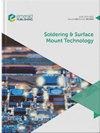不同直径Sn-37Pb焊点在热冲击过程中的性能
IF 1.8
4区 材料科学
Q3 ENGINEERING, ELECTRICAL & ELECTRONIC
引用次数: 2
摘要
采用板级试验方法对焊点在高应变速率下的冲击强度进行了评价。然而,单个焊点的冲击剪切测试比板级测试方法更方便、更经济。随着焊点的小型化,焊点在热冲击下更容易失效,焊点的冲击可靠性越来越受到重视。但是无铅焊点可能被过分关注,而Sn-Pb焊点可能被忽略。,在本研究中,对BGA封装中的Sn-37Pb焊料凸点进行了−55°C至125°C之间的热冲击试验,以研究界面金属间化合物(IMCs)层的微观结构演变和生长机制。讨论了热冲击和球径对Sn-37Pb焊点力学性能和断裂行为的影响。,随着球尺寸的增加,剪切强度随热冲击循环的变化趋势相同。回流焊后焊点的剪切强度最高;随着热冲击次数的增加,焊点的剪切强度降低。但在2000次循环时,剪切强度增加到初始强度。在所有焊料凸块中,最小剪切强度几乎在1500次循环时发生。最大抗剪强度和最小抗剪强度之间的差异为9.11 MPa和16.83 兆帕,17.07 MPa和15.59 MPa,φ0.3 mm和φ0.4 mm,φ0.5 mm和φ0.6 mm,差异随着球大小的增加而增加。在类似的回流剖面下,IMC的厚度随着球直径的增加而减小。IMC的厚度为2.42 µm和2.17 µm,1.63 µm和1.77 µm。,无铅焊料逐渐取代了传统的锡铅焊料,在工业上得到了广泛的应用。然而,一些产品不可避免地使用Sn-Pb和无铅焊料的混合物来从Sn-Pb过渡到无铅焊料。因此,了解Sn-Pb焊点的可靠性具有重要意义,还需要进一步的研究。本文章由计算机程序翻译,如有差异,请以英文原文为准。
Property of Sn-37Pb solder bumps with different diameter during thermal shock
The impact strength of solder joint under high strain rate was evaluated by board level test method. However, the impact shear test of single solder bump was more convenient and economical than the board level test method. With the miniaturization of solder joints, solder joints were more prone to failure under thermal shock and more attention has been paid to the impact reliability of solder joint. But Pb-free solder joints may be paid too much attention and Sn-Pb solder joints may be ignored.,In this study, thermal shock test between −55°C and 125°C was conducted on Sn-37Pb solder bumps in the BGA package to investigate microstructural evolution and growth mechanism of interfacial intermetallic compounds (IMCs) layer. The effects of thermal shock and ball diameter on the mechanical property and fracture behavior of Sn-37Pb solder bumps were discussed.,With the increase of ball size, the same change tendency of shear strength with thermal shock cycles. The shear strength of the solder bumps was the highest after reflow; with the increase of the number of thermal shocks, the shear strength of the solder bumps was decreased. But at the time of 2,000 cycles, the shear strength was increased to the initial strength. Minimum shear strength almost took place at 1,500 cycles in all solder bumps. The differences between maximum shear strength and minimum shear strength were 9.11 MPa and 16.83 MPa, 17.07 MPa and 15.59 MPa in φ0.3 mm and φ0.4 mm, φ0.5 mm and φ0.6 mm, respectively, differences were increased with increasing of ball size. With similar reflow profile, the thickness of IMC decreased as the diameter of the ball increased. The thickness of IMC was 2.42 µm and 2.17 µm, 1.63 µm and 1.77 µm with increasing of the ball size, respectively.,Pb-free solder was gradually used to replace traditional Sn-Pb solder and has been widely used in industry. Nevertheless, some products inevitably used a mixture of Sn-Pb and Pb-free solder to make the transition from Sn-Pb to Pb-free solder. Therefore, it was very important to understand the reliability of Sn-Pb solder joint and more further research works were also needed.
求助全文
通过发布文献求助,成功后即可免费获取论文全文。
去求助
来源期刊

Soldering & Surface Mount Technology
工程技术-材料科学:综合
CiteScore
4.10
自引率
15.00%
发文量
30
审稿时长
>12 weeks
期刊介绍:
Soldering & Surface Mount Technology seeks to make an important contribution to the advancement of research and application within the technical body of knowledge and expertise in this vital area. Soldering & Surface Mount Technology compliments its sister publications; Circuit World and Microelectronics International.
The journal covers all aspects of SMT from alloys, pastes and fluxes, to reliability and environmental effects, and is currently providing an important dissemination route for new knowledge on lead-free solders and processes. The journal comprises a multidisciplinary study of the key materials and technologies used to assemble state of the art functional electronic devices. The key focus is on assembling devices and interconnecting components via soldering, whilst also embracing a broad range of related approaches.
 求助内容:
求助内容: 应助结果提醒方式:
应助结果提醒方式:


